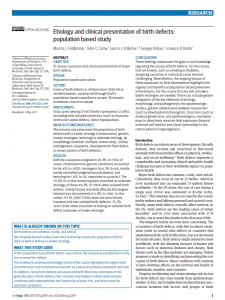
Objective
To assess causation and clinical presentation of major birth defects.
Design
Population based case cohort.
Setting
Cases of birth defects in children born 2005-09 to resident women, ascertained through Utah’s population based surveillance system. All records underwent clinical re-review.
Participants
5504 cases among 270 878 births (prevalence 2.03%), excluding mild isolated conditions (such as muscular ventricular septal defects, distal hypospadias).
Conclusions
These findings underscore the gaps in our knowledge regarding the causes of birth defects. For the causes that are known, such as smoking or diabetes, assigning causation in individual cases remains challenging. Nevertheless, the ongoing impact of these exposures on fetal development highlights the urgency and benefits of population based preventive interventions. For the causes that are still unknown, better strategies are needed. These can include greater integration of the key elements of etiology, morphology, and pathogenesis into epidemiologic studies; greater collaboration between researchers (such as developmental biologists), clinicians (such as medical geneticists), and epidemiologists; and better ways to objectively measure fetal exposures (beyond maternal self reports) and closer (prenatally) to the critical period of organogenesis.